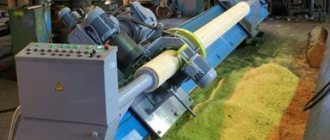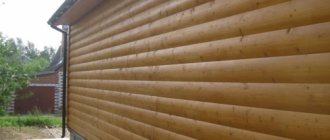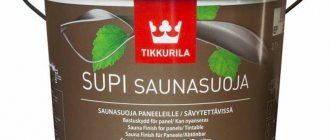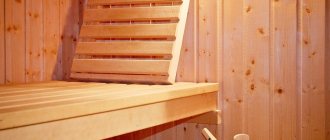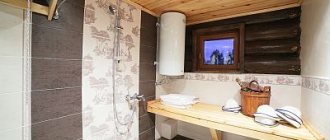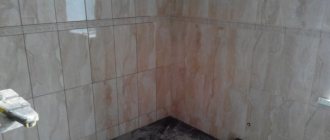SHARE ON SOCIAL NETWORKS
FacebookTwitterOkGoogle+PinterestVk
Today, a real Russian bathhouse is considered not only a luxury item and a tribute to fashion, but is also an integral part of a healthy lifestyle. The structure for bath procedures can be made from any building material, but it can only become a real health resort from wooden products. Log baths are a classic embodiment of a real Russian tradition, where you can not only relax, but also get a real charge of vivacity and health.
You can build a log bathhouse with your own hands or order turnkey construction from a specialized company
What is bath finishing?
Finishing a bathhouse is not a specific term, but a collective one. Finishing a bathhouse can mean applying one surface to another in order to make the first surface more protected or attractive outside or inside. There is also another broader meaning, which means finishing, as well as the installation of various missing elements of the bathhouse, which are left for last, for example, finishing the floor, ceiling, installing stairs, installing windows and doors, finishing with decorative elements, and so on. This article will consider only the narrow meaning of bathhouse finishing. So, let's start studying the expert material.
What is a chopped log?
Chopped logs are a wood material for the construction of a bathhouse, which is least subject to mechanical impact during processing. After cutting the log to dry, only the rough layer of bark is removed with an ax, thereby laying down the fibers and leaving a protective thin layer of wood. Such a log usually does not have ready-made cuts, locks and grooves, so during construction all this is done manually, based on the design. Due to such a small impact on the log, it has a natural appearance and a thin surface protective layer. Even after grinding, a chopped log looks natural, which cannot be said about a rounded log, which requires grinding even after machine processing.
Exterior finishing of a bathhouse made of chopped logs
The exterior finishing of a chopped log is usually not done with decorative wood trim, as the log itself creates a superior appearance. Most often it is sanded using a grinder with a sanding attachment. After which it is coated with a composition that gives the wood contrast, and with stronger sanding the wood can be colored. Good paints for this are glazes from the Belinka company. But there are times when, for some reason, a bathhouse made of chopped logs has changed color, the seams turned out to be ugly and the logs are too different, then decorating the walls with clapboard will help you out. Lining has many varieties - classic lining, eurolining, imitation timber, block house (imitation log). The classic lining for a bathhouse is not suitable, since it does not have air ducts on the back side. A good option for you is to use eurolining or block house (imitation logs), however, eurolining will be faster to assemble, has its own original appearance and is cheaper. Block house is a large wooden product that imitates a log. It is a little more difficult to assemble and the price is more expensive.
Interior decoration of a bathhouse made of chopped logs
The inside of a bathhouse made of chopped logs is also more often treated with impregnation to give contrast, oil, and impregnation for coloring than with finishing materials. However, if you don’t like the walls of the log bathhouse for some reasons, which may be described above, then you can use finishing materials made of wood.
As mentioned above, it is better to use imitation timber inside due to the good average size of the product, which does not narrow the space. Eurolining is also suitable with its excellent appearance and quick assembly.
When selecting lining, choose the right species that is suitable for finishing the bathhouse. It is better to choose moisture-resistant species for exterior work, and moisture-resistant and resistant to temperature changes inside.
General requirements for the characteristics of bathhouses
The wood in the steam room must be resistant to high temperatures.
The bathhouse, even a small one, is divided into 4 zones: treatment room - steam room or sauna, washing area, relaxation area - dressing room, possibly a swimming pool, technical area - toilet, transit area - corridor. The latter may be missing.
The bath project can be complemented by a guest room.
The finishing of the sauna and washing room is not exactly the same. It is better to consider the requirements separately.
- Sauna – the air temperature here reaches +110 C, but the humidity is very low. The main requirement for cladding is temperature resistance and low thermal conductivity, otherwise the surface of walls and shelves will burn human skin.
- Steam room - the temperature rarely exceeds +60 C, humidity, depending on the type of bath, varies from 80 to 100%. The finish must be resistant to steam, hot water, and temperature.
- Washing room - the room temperature is not higher than a comfortable 28–30 C, the humidity level is quite high. But it is not specifically supported, but is only determined by the frequency of showering. It is better to line the washing area with materials that are as resistant to water and high humidity as possible.
The dressing room can be either a real relaxation area - a room with a table and a sofa, or a simple dressing room. There are no special requirements for finishing, but the room should look cozy.
The technical area includes a toilet and additional rooms that increase comfort: a firewood shed, storage for bath accessories and fixtures, and a locker room.
The corridor allows you to go to the dressing room or steam room. This area should not be neglected: a person leaving the steam room into the dressing room takes out moisture and lets steam into the room. A person coming in from the street creates a draft and lets in the cold.
What materials will be needed to carry out finishing work in a log bathhouse. Expert opinion
After completion of construction, a log bathhouse, like any other building, requires interior finishing. This work process can be called jewelry. It requires attention, precision and accuracy from the performer. Any error will be visible, and it is very difficult to hide or correct it in the future. Any materials can be used for finishing work on a log bath; they are available in a wide range on the construction market. But before purchasing and using it, you need to take into account the characteristics of each room in the bathhouse.
Materials for finishing a steam room in a log bath
To decorate a steam room in a log bathhouse, it is recommended to use only wood. In this case, you only need to purchase deciduous species, such as aspen, linden, abash, etc. Their structure does not contain resin substances that can harm bathhouse visitors. The main material for finishing a steam room in a bathhouse is lining, of various sizes and sections. It can be used for covering walls and ceilings indoors.
Hardwood allows the room to heat up quickly and retains heat well. At the same time, a bathhouse visitor will not be able to get even a minor burn on the skin when coming into contact with wood. They retain heat well, have good density and, most importantly, fill the room with pleasant, healthy forest aromas.
The floor in the steam room can be finished with tongue and groove or edged boards or tiles.
Wall insulation
If the walls in the bathhouse are built from foam blocks or using frame technology, then the steam room requires additional insulation.
The inside should be a cold-proof thermos that will perfectly retain the heat emanating from the stove. This will save fuel, which is used for heating and maintaining the desired temperature in the steam room for a long time. Before starting work, an opening is cut in the wall to install the stove.
Oven opening
Then a wind and vapor barrier film is attached to the walls.
Vapor barrier
Next, screw the bars 50 mm thick and 40 mm wide. The distance between them should be equal to the width of the insulation boards.
At the next stage, basalt non-combustible insulation is tightly laid between the bars.
Lathing and laid insulation
Prices for basalt wool
basalt wool
After this, a water vapor barrier is nailed to the bars with galvanized staples.
Foil insulation and counter-lattice for lining
The following can be used as protective material:
- foil with a density from 150 to 200 microns;
- foil foamed penoizol;
- waterproofing membrane for a bath.
Strips of moisture-resistant material are nailed with staples, overlapping each other by at least 15 cm, and the joints are sealed using special tape.
Then slats 25 mm thick and 30 to 50 mm wide are horizontally attached to the bars using galvanized self-tapping screws at a distance of 70 cm from each other. The sheathing should be installed as level as possible; for this you should use a laser level or plumb line. Installation begins with the two outer slats, then a cord is pulled between them. And already focusing on it, they nail down the remaining parts of the sheathing.
At the next stage, the clapboard board is directly attached. To do this, use either ordinary galvanized nails 40-50 mm long, or special clamps.
Finally, even holes are cut in the walls for ventilation. They are masked from above with plugs or flaps. If necessary, install a fan in the supply or exhaust opening.
Prices for lining
lining
If the walls in the steam room are made of logs or profiled timber, then they do not require such careful insulation. In this case, it will be enough to attach foil or foil penoizol to them. Then nail the sheathing and install the lining.
Materials for finishing a relaxation room in a log bathhouse
You can use any finishing materials to decorate a relaxation room in a log bathhouse. This can be plasterboard (necessarily moisture-resistant), artificial or even natural stone, plaster, etc. All decoration of the rest room can be done according to the taste and desires of the owner, taking into account the style of all rooms in the bathhouse. The main condition when choosing is that the material must be safe and natural.
The log walls in the recreation room do not need to be covered. Logs have an interesting texture and can create a unique atmosphere in a room. It is only necessary to periodically provide them with the necessary protection from moisture and the possible formation of biological pests.
Peculiarities
The main feature of the Russian bath is wet steam. To create it, a certain humidity is maintained in the steam room. Humidity and steam balance is achieved by a complete lack of ventilation.
There are a huge number of options for finishing bath rooms. The choice depends on personal preferences and is limited by financial capabilities. The features of the interior decoration should traditionally be conducive to relaxation and spiritual pleasure. Therefore, the main thing in interior decoration is naturalness, convenience, and minimalism.
Additional materials should not negatively affect the basic requirements for the bath:
Properly selected materials will have a positive impact on the functional features of the bathhouse. They will also affect the service life of the walls, floors, and ceilings of the premises.
Many materials may not withstand such an extreme situation. However, the modern market offers a lot of interesting finishing options that best suit the conditions of the steam room.
The finishing features for the steam room should be as follows:
- have the ability to warm up and not accumulate heat;
- be moisture resistant;
- have good aesthetic characteristics;
- be resistant to fungus and mold;
- have the ability to purify the air.
The washing room involves not only washing, but also relaxation. Classic choice: wood, ceramic tiles. For washing, for example, coniferous wood is suitable. It has high water-repellent qualities. In addition, conifers have a beautiful appearance. The floor in this room should have anti-slip properties, as well as a comfortable temperature. Ceramic tiles can help achieve results.
As a reliable material for the vestibule and rest room, you can choose:
Expert recommendations
In order for a log bathhouse to serve its maximum service life, it is important to properly and carefully maintain the premises.
- Natural ventilation of the premises must be organized. Fresh air will help quickly dry wooden materials that are most exposed to moisture.
- In the washing and steam room, after all procedures have been completed, cleaning must be done (everything needs to be swept, washed, put away) and then thoroughly ventilated. If possible, it is advisable to move all furniture outside.
- To provide additional protection, wooden materials periodically need to be treated with protective impregnations. They will prevent rotting, the appearance of fungi and mold. But the compositions must be intended specifically for the bath, without containing harmful and dangerous substances in their composition.
Any finishing materials for the bath can be used at the request of the owners. But the main thing is that they are natural, safe, moisture-resistant, not afraid of temperature changes and retain heat well.
What else to finish?
Large public baths, starting from Ancient Rome, were and are now often finished with mineral materials - stone, tiles. They are definitely not suitable for a small bathhouse: as the size of the building decreases, per unit of its volume there is an increasing area of external surfaces, and with it heat loss. Then, to make a stone bath breathe, it needs high, from 4-5 m, ceilings and well-designed ventilation and hot air supply systems; The design of the Roman baths still fascinates engineers and builders.
Have you been to the hammam? How high is it from the heels of the person standing in pairs to the lowest point of the ceiling? If less than 4.2 m, then what kind of equipment is hidden in the technical premises? How much does it cost, consume fuel and electricity? In a private household, the interior decoration of the bathhouse should, without alternative, be wooden. This makes it difficult for it to achieve proper hygiene, but there is no other way to install a healthy sauna with dimensions less than approx. 12x16 m no.
